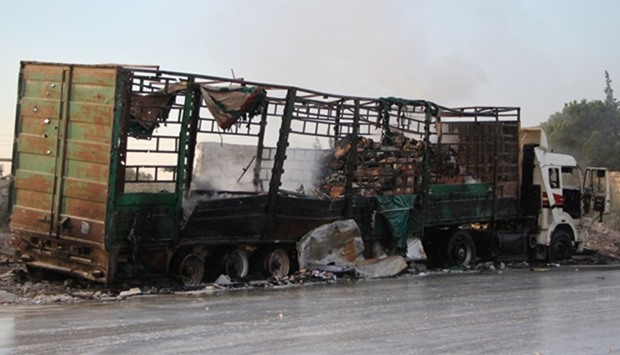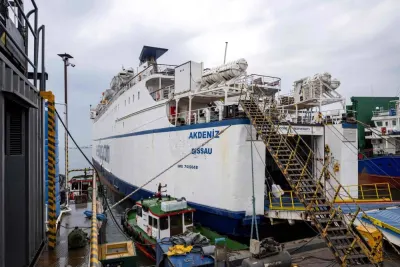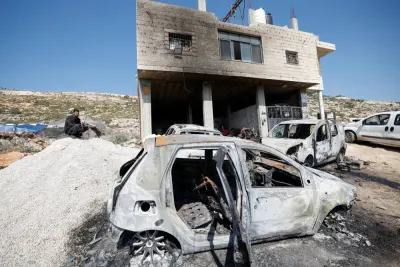* Civil Defence said many strikes made rescue work harder
* Syrian government and Russia deny charges they were responsible
Surveillance aircraft circled in the sky during the hours before a United Nations aid convoy was struck by warplanes on Monday, killing relief workers and destroying 18 trucks of humanitarian supplies, several witnesses said.
Rebels and local rescue workers say the surveillance shows the strikes, which have drawn outrage from the United Nations and Western countries, were deliberate, and gives the lie to Russian and Syrian government denials that they were involved.
‘We thought at first something was going to happen because there were four or five planes in the air, but they didn't strike at first,’ said Abu Shahoud, an opposition activist who was present when the attack took place on Monday.
Hussein Badawi, head of the Civil Defence local rescue service in the town of Urem al-Kubra, who was 100 metres (yards) from the aid depot when the attack took place and was injured by shrapnel in the hand, described relentless and sustained air attacks that unleashed carnage on workers unloading aid trucks.
‘There were fires, martyrs, wounded people. We were able to pull out four survivors and five dead bodies at first,’ Badawi said.
‘The bombardment was continuous, continuous. The rescue teams weren't even able to work. Those who arrived in ambulances couldn't come in,’ he added. Several truck drivers and volunteers offloading the aid were killed, he said.
‘This is an area that wasn't supposed to be bombed, belonging to an international humanitarian organisation... This area is full of civilians, it's residential,’ Badawi said.
Damascus and Moscow both say their aircraft were not responsible for attacking the convoy. Russia said only rebel fighters knew the convoy's location. But the United Nations says all sides were informed of the convoy's whereabouts and the trucks were clearly marked.
The attack on the convoy took place as a week-long ceasefire agreement appeared to unravel, with violence escalating across the country and Syria's military declaring the truce to be over.
The war pits Syrian President Bashar al-Assad, backed by Russia, Iran and Arab Shia militias, against a myriad of Sunni rebel groups, including some supported by the United States, Turkey and Gulf Arab states.
The five-year conflict has already been marked by a devastating human toll, killing hundreds of thousands, displacing half the country's original population and including poison gas attacks, starvation sieges and raids on hospitals.
Abu Shahoud, the opposition activist, said workers had been worried enough by the presence of aircraft to evacuate the area, a Syrian Arab Red Crescent aid depot near Urem al-Kubra 14km (nine miles) west of Aleppo, where 31 trucks carrying food and winter clothes were unloading, he said.
The Syrian Red Crescent says the head of its office in the town was killed, along with around 20 civilians.
The convoy had been tracked from the skies since it left Aleppo in the morning, a rebel who was part of an escort accompanying it said, adding that fighters had shot at the planes, trying to bring them down, but had missed.
The convoy reached Urem al-Kubra in the late morning to unload wheat flour, winter clothes and blankets, food and educational supplies for 78,000 people. A Red Crescent team from Aleppo handed it over to one from Urem al-Kubra to oversee the convoy's unloading.
CIRCLING DRONES
Drones were circling again from around 6:30 p.m., said Badawi of the Civil Defence. The strikes began sometime after 7:00 p.m. There were conflicting accounts of whether it was jets or helicopters that first opened fire, and of how many strikes, using which weapons, took place.
However, several rebels and rescue workers said attacks were carried out both by jets firing very accurate missiles, which they presume to be Russian, and by low-flying jets and helicopters firing machine guns and dropping imprecise barrel bombs, which they presume to belong to the Syrian army.
Several opposition activists noted that Russia's state-funded RT television channel had on Monday broadcast footage sourced to live video feeds on Moscow's Defence Ministry website that were monitoring the ceasefire.
The pictures showed the Urem al-Kubra aid centre, they said. The live feeds were switched off later on Monday, Russian news service Interfax said, quoting the ministry, because of militant attacks damaging the camera in southwest Aleppo.
AFTERMATH
Video footage from after the attack showed a Civil Defence member pointing towards burning buildings surrounded by rubble, twisted metal and damaged vehicles, pointing out what he said was the aftermath of the strike.
In the video, distributed by the Civil Defence, he showed items in the rubble marked with the logos of international and local charities. Other workers in hard hats could be seen picking through the debris.
Photographs showed smouldering buildings, discarded aid bundles and the skeletal, burned out carcasses of trucks.
Along with the aid depot and 18 trucks, the strikes also destroyed a building that housed a printing press that produced stationery and school books, said Ammar Selmo, head of Civil Defence in Aleppo, who was in Urem al-Kubra on Monday, said.
‘It wasn't until 3:00 am that we were able to put out the fires and pull out the wounded and martyrs,’ he said.



